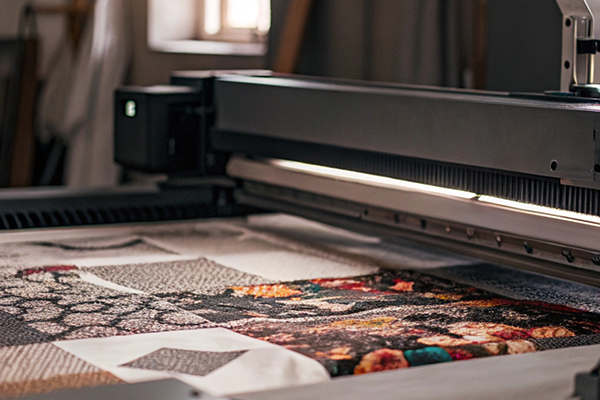Direct-to-Film (DTF) printing is transforming the fabric printing industry1 with its versatility and efficiency. Unlike traditional printing methods2, DTF printing allows designs to be transferred directly onto a film and then onto a wide range of fabrics using heat. This innovation has gained popularity among small businesses, custom apparel makers, and large-scale manufacturers.
DTF printing is a fabric printing technique where designs are printed on a special film, coated with adhesive powder, and transferred to fabric using a heat press, offering unmatched versatility for different materials.
In this article, we’ll explore whether DTF printers are the future, how they compare to sublimation printing3, and whether they outperform screen printing4.
Are DTF printers the future of fabric printing?
With the rise of new printing technologies, DTF printing is emerging as a game-changer in the fabric printing industry.
DTF printers are considered the future of fabric printing due to their ability to work on diverse fabrics, provide high-quality results, and reduce production time and cost.

Why DTF is Gaining Popularity
-
Works on Any Fabric
- DTF printing is not limited to polyester or white fabrics. It works seamlessly on cotton, nylon, denim, and even dark materials.
-
No Pretreatment Required
- Unlike Direct-to-Garment (DTG) printing5, DTF doesn’t require pretreating the fabric, saving time and effort.
-
Cost-Effective for Small Runs
- DTF printing is ideal for small-batch or custom orders since it doesn’t rely on expensive setups like screen printing.
-
Durable and Vibrant Prints
- The adhesive powder and heat transfer process ensure that the prints are vibrant and long-lasting, withstanding multiple washes.
Advantages Over Other Printing Methods
| Feature | DTF Printing | Other Methods |
|---|---|---|
| Versatility | Prints on any fabric | Limited to specific materials |
| Setup Cost | Low for small runs | High for screen printing setups |
| Durability | High (long-lasting prints) | Varies by method |
Challenges Facing DTF Printing
-
Initial Investment
- While cheaper than screen printing, DTF printers can still be expensive for beginners.
-
Powder Residue
- Improper application of adhesive powder may affect the quality of the print.
Despite these challenges, DTF printing’s versatility and ease of use make it a strong contender for the future of fabric printing.
Is DTF printing better than sublimation?
Sublimation printing3 has long been a favorite for vibrant, high-quality designs, but DTF offers new possibilities.
DTF printing is better than sublimation for printing on a variety of fabrics, while sublimation is ideal for polyester materials and items with hard coatings.

DTF Printing: Key Strengths
-
Works on Multiple Fabrics
- DTF can print on cotton, polyester, leather, and more, making it more versatile than sublimation.
-
No Material Color Restrictions
- DTF works well on both light and dark fabrics without requiring a white base layer.
-
Durability
- DTF prints resist fading and cracking even after repeated washes.
Sublimation Printing: Where It Excels
-
Vibrant Colors on Polyester
- Sublimation embeds ink directly into polyester fibers, producing vivid, long-lasting colors.
-
Specialty Products
- Ideal for hard surfaces like mugs, mousepads, and phone cases.
-
Eco-Friendliness
- Sublimation doesn’t require adhesive powders or films, reducing waste.
Comparison: DTF vs. Sublimation
| Feature | DTF Printing | Sublimation Printing |
|---|---|---|
| Fabric Compatibility | Works on all fabrics | Limited to polyester |
| Color Vibrancy | High, even on dark fabrics | Best on light polyester fabrics |
| Durability | Long-lasting | Extremely durable on polyester |
| Cost for Setup | Moderate | Low |
DTF printing wins in versatility, while sublimation remains unmatched for polyester and specialty products.
Is screen printing better than DTF?
Screen printing4 has been the gold standard for large-scale printing for decades, but DTF offers unique advantages for customization and smaller projects.
Screen printing is better for bulk orders and large designs, while DTF excels in small runs, detailed designs, and multi-fabric compatibility.

Screen Printing: Strengths and Limitations
-
Best for Bulk Orders
- Screen printing is cost-effective for large quantities due to economies of scale.
-
Vibrant Colors
- It produces vivid and opaque colors, especially on dark fabrics.
-
Setup Costs
- High initial costs make it less suitable for small-batch printing.
-
Fabric Limitations
- Works best on cotton and polyester but struggles with complex fabrics like nylon or leather.
DTF Printing: Why It’s Competitive
-
Small-Batch Flexibility
- No need for screens or stencils means DTF can easily handle single pieces or custom designs.
-
High Detail Resolution
- DTF can capture intricate designs and gradients better than screen printing.
-
Ease of Use
- DTF is less labor-intensive, making it accessible to small businesses and individuals.
Comparison: DTF vs. Screen Printing
| Feature | DTF Printing | Screen Printing |
|---|---|---|
| Best For | Small runs, multi-fabric designs | Large quantities, simple designs |
| Setup Cost | Low | High |
| Detail Resolution | Excellent | Moderate (depends on design) |
| Fabric Compatibility | All fabrics | Limited (cotton, polyester) |
While screen printing remains the go-to for bulk production, DTF’s adaptability and ease of use make it a better option for custom and small-scale projects.
Conclusion
DTF printing is revolutionizing fabric printing with its versatility, vibrant results, and ease of use. While it’s not without challenges, such as adhesive powder handling and initial investment costs, its ability to print on diverse fabrics and small runs makes it a highly attractive option for businesses and hobbyists alike. Compared to sublimation and screen printing, DTF stands out as the most adaptable solution, blending the best of both worlds. As technology advances, DTF printing is poised to become a cornerstone of modern fabric printing.













